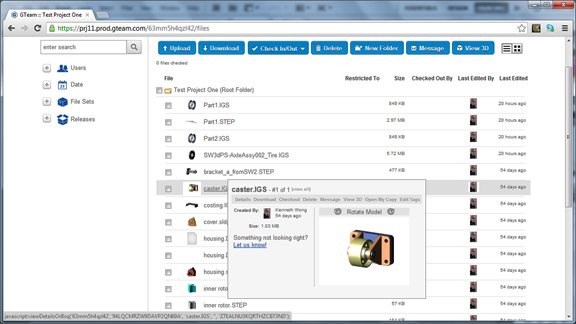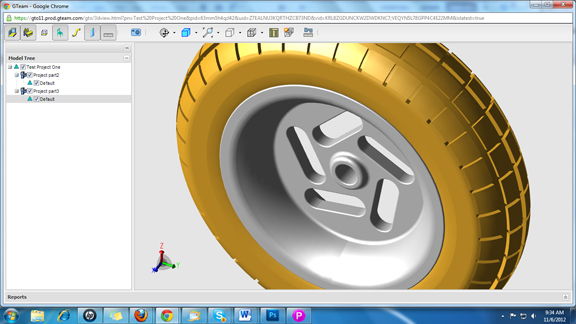Latest News
November 6, 2012
Normally I would have no reason to blog about a collaboration application developed by an architecture firm in Virtual Desktop, devoted to a primarily mechanical crowd. But the firm in question happens to be Gehry Technologies, which uses Dassault Systemes’ CATIA as the foundation of its architecture modeler. Several months ago, the same firm went public with a browser-based, cloud-hosted collaboration application dubbed GTeam. The system supports, among other things, CATIA and SolidWorks files in their native form. This makes the product relevant to my readers, even if they’re not architects.
GTeam has no download, no software to install. Once you’ve created your account and logged in, you’re in GTeam’s project space. The program supports a healthy variety of neutral 3D formats, including IGES and STEP. The interface has a built-in calendar, which keeps tracks of file uploads and changes to give you a historical perspective of the project. When you hover your mouse over an item, you get thumbnail previews of the files, a convenient way to identify the item before you launch it in the viewer. Traditional thumbnails are static images, but GTeam thumbnails let you rotate them.
The viewer in GTeam has two levels. At the basic level, it gives you normal navigation commands, such as zoom, pan, rotate. If your 3D file contains multiple parts, you may hide or show selected objects. The next level is the advanced or detailed 3D view. In this environment, you can more controls. Preset orientations give you easy access to front, back, top, and other standard perspectives. There’s a measurement tool to obtain distances between edges, features, and points. For closer inspection of models, you may activate the cross-section view with drag handles (dragging the cross-sectioning plane reveals the model’s interior).
The 3D view supports multiple files. You can, for example, launch two or three parts maintained by different users in the same view window, which will be handy for online discussions. In some cases, you may even be able to use the Clash tool to detect clashes and clearances when viewing multiple files.
One anomaly I discovered is the placement of the items. By default, the viewer seems to place everything at the origin of the virtual space, at the intersection of XYZ. That results in some cases in misaligned assembly components. Some of the architecture-specific functions in the viewer—like the ability to filter furniture, plumbing, and electrical components—won’t be applicable to a mechanical CAD user.
GTeam is more than a simple viewer. The interface is complete with tracking mechanism for edits, revisions, and check in/checkout—some of the basic functions you’d expect in a data management system. It gives you the option to sync online content with a dedicated local folder, so your offline and online files can be always the same. You may also use the Release function to send files privately to subcontractors you work with. Administrators have the option to customize invited users’ rights (such as the right to release files).
If you need a low-maintenance project management and online collaboration space for a team, GTeam is worth investigation. The fact that it’s developed by an architecture firm shouldn’t stop you. After all, the software doesn’t care that you’re not using it for an architecture project.
For more, watch the video demo below:
Subscribe to our FREE magazine, FREE email newsletters or both!
Latest News
About the Author
Kenneth Wong is Digital Engineering’s resident blogger and senior editor. Email him at [email protected] or share your thoughts on this article at digitaleng.news/facebook.
Follow DE







